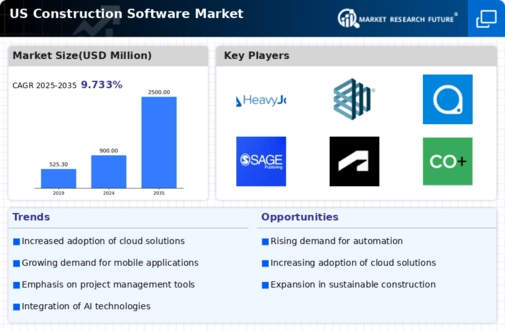The US Construction Software Market is characterized by a dynamic and competitive landscape where various players strive to enhance operational efficiency, streamline project management, and improve collaboration among stakeholders in the construction sector. This market has witnessed significant advancements driven by technological innovations, including cloud computing, mobile accessibility, and data analytics. Key trends shaping the competitive environment include increasing demand for integrated solutions, emphasis on project profitability, and the growing importance of regulatory compliance.
As construction projects become increasingly complex, software solutions that focus on real-time data and analytics are gaining traction, positioning vendors to better serve the multifaceted needs of the industry. Understanding the competitive insights within this market involves an analysis of leading firms, emerging competitors, and the unique value propositions they offer to construction professionals. HeavyJob has established itself as a prominent player in the US Construction Software Market by focusing on job cost tracking, time management, and reporting functionalities designed specifically for the construction industry's unique needs.
The company’s strengths lie in its robust mobile platform, which provides on-the-go access to essential project data, enhancing workforce efficiency and accountability. HeavyJob's software empowers construction managers and teams to monitor project performance in real-time, leading to informed decision-making and timely interventions.
This capability is especially critical in a market where large projects are increasingly susceptible to delays and budget overruns. By equipping contractors with the tools necessary for precise job costing and streamlined operations, HeavyJob effectively addresses pain points within the construction process, contributing to a stronger position in the market. Viewpoint is another key competitor in the US Construction Software Market, offering a suite of integrated solutions targeting various aspects of construction management, including accounting, project management, and risk management. The company is well-known for its flagship products, which assist construction firms in achieving operational efficiency and financial control.
Viewpoint’s strengths lie in its comprehensive capabilities to facilitate collaboration and communication among teams, ultimately driving project success. The company has been active in enhancing its market presence through strategic mergers and acquisitions that have expanded its product offerings and customer base. Such initiatives signal Viewpoint’s commitment to maintaining relevance in an evolving market. As construction companies increasingly seek integrated solutions to address fragmented workflows, Viewpoint’s focus on providing holistic and adaptable tools places it in a strong competitive position, bolstered by its ongoing efforts to innovate and respond to sector demands.























